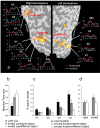Dynamic interaction of object- and space-based attention in retinotopic visual areas
- PMID: 14586009
- PMCID: PMC6740895
- DOI: 10.1523/JNEUROSCI.23-30-09812.2003
Dynamic interaction of object- and space-based attention in retinotopic visual areas
Abstract
We investigated the interaction between object- and space-based attention by measuring activity in early visual cortex. After central cueing, when subjects directed attention to a spatially defined part of an object, activity in early visual areas was enhanced at corresponding retinotopic representations but also at representations of other locations covered by the object. Different from the assumption of automatic attentional "spreading" within an object, however, activity was greater for representations of cued than of uncued locations on the same object. These findings support an interaction of object-based spatial selection with object-independent spatial mechanisms in directing attention. When the target stimulus did not appear at the expected location, we found higher activation in areas representing other locations on the same object than equidistant locations on other objects. Objects, hence, also guide spatial search, and this may account for the behaviorally observed delay in processing parts of an unattended object.
Figures


Similar articles
-
Object Selection by Automatic Spreading of Top-Down Attentional Signals in V1.J Neurosci. 2020 Nov 25;40(48):9250-9259. doi: 10.1523/JNEUROSCI.0438-20.2020. Epub 2020 Oct 21. J Neurosci. 2020. PMID: 33087475 Free PMC article.
-
The retinotopy of visual spatial attention.Neuron. 1998 Dec;21(6):1409-22. doi: 10.1016/s0896-6273(00)80659-5. Neuron. 1998. PMID: 9883733
-
A functional MRI study of preparatory signals for spatial location and objects.Neuropsychologia. 2005;43(14):2041-56. doi: 10.1016/j.neuropsychologia.2005.03.020. Epub 2005 Apr 26. Neuropsychologia. 2005. PMID: 16243051
-
Visual streams and shifting attention.Prog Brain Res. 2009;176:47-63. doi: 10.1016/S0079-6123(09)17604-5. Prog Brain Res. 2009. PMID: 19733749 Review.
-
Cortical mechanisms of space-based and object-based attentional control.Curr Opin Neurobiol. 2003 Apr;13(2):187-93. doi: 10.1016/s0959-4388(03)00033-3. Curr Opin Neurobiol. 2003. PMID: 12744972 Review.
Cited by
-
Cortical systems mediating visual attention to both objects and spatial locations.Proc Natl Acad Sci U S A. 2006 Jul 25;103(30):11387-92. doi: 10.1073/pnas.0601813103. Epub 2006 Jul 13. Proc Natl Acad Sci U S A. 2006. PMID: 16840559 Free PMC article.
-
Cross-modal processing in early visual and auditory cortices depends on expected statistical relationship of multisensory information.J Neurosci. 2006 Nov 22;26(47):12260-5. doi: 10.1523/JNEUROSCI.1457-06.2006. J Neurosci. 2006. PMID: 17122051 Free PMC article.
-
fMRI correlates of object-based attentional facilitation vs. suppression of irrelevant stimuli, dependent on global grouping and endogenous cueing.Front Integr Neurosci. 2014 Feb 10;8:12. doi: 10.3389/fnint.2014.00012. eCollection 2014. Front Integr Neurosci. 2014. PMID: 24574982 Free PMC article.
-
Object-based attention requires monocular visual pathways.Psychon Bull Rev. 2024 Aug;31(4):1880-1890. doi: 10.3758/s13423-024-02467-7. Epub 2024 Feb 13. Psychon Bull Rev. 2024. PMID: 38351255 Free PMC article.
-
Object-based attention guided by an invisible object.Exp Brain Res. 2012 Nov;223(3):397-404. doi: 10.1007/s00221-012-3268-4. Epub 2012 Sep 19. Exp Brain Res. 2012. PMID: 22990295
References
-
- Abrams RA, Law MB ( 2000) Object-based visual attention with endogenous orienting. Percept Psychophys 62: 818–833. - PubMed
-
- Avrahami J ( 1999) Objects of attention, objects of perception. Percept Psychophys 61: 1604–1612. - PubMed
-
- Awh E, Dhaliwal H, Christensen S, Matsukura M ( 2001) Evidence for two components of object-based selection. Psychol Sci 12: 329–334. - PubMed
-
- Baylis GC, Driver J ( 1993) Visual attention and objects: evidence for hierarchical coding of location. J Exp Psychol Hum Percept Perform 19: 451–470. - PubMed
-
- Brefczynski JA, DeYoe EA ( 1999) A physiological correlate of the “spotlight” of visual attention. Nat Neurosci 2: 370–374. - PubMed
Publication types
MeSH terms
LinkOut - more resources
Full Text Sources
